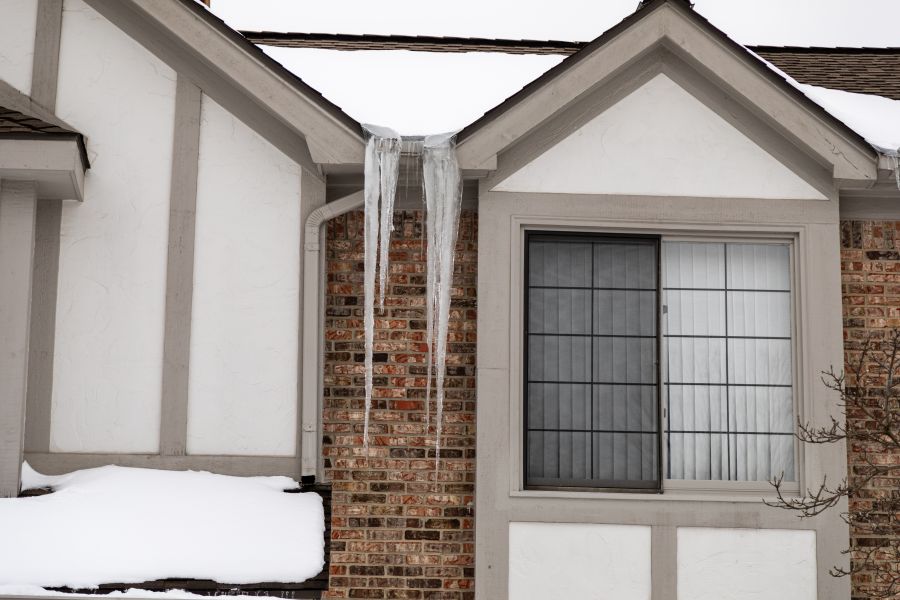
Denver’s first snow means winter is no longer knocking at the door but officially come in and made itself comfortable. We want you to be focusing on enjoying more time with friends and family and drinking your fill of hot chocolate. The last thing we want on your mind is an issue with your home due to the colder weather. To avoid this, schedule an appointment with Strouse Home Inspections ASAP. Home inspections are a critical part of maintaining a property’s integrity, whether you’re buying, selling, or simply conducting routine upkeep. While inspections are important year-round, conducting a home inspection during the winter months requires special attention to cold-weather issues. Winter conditions can uncover or exacerbate certain problems that may go unnoticed during warmer seasons. What can a home inspection reveal and how can that help? We’ll take a look at some areas that are examined in home inspections.
Roof Integrity and Snow Load
Winter inspections offer a unique opportunity to assess a roof’s performance under cold weather stress. Heavy snow accumulation can lead to increased weight on the roof, and poor roofing conditions can make a home vulnerable to leaks or even structural damage. A thorough winter inspection will evaluate:
- Ice Dams: Ice dams occur when heat escapes through the roof, causing snow to melt and refreeze near the roof’s edges. This can result in water backing up and leaking into the home. Inspecting for ice dams and checking the attic insulation can help prevent costly water damage.
- Shingles and Flashing: Cold weather may make it easier to spot worn or damaged shingles, missing flashing, or gaps that could allow moisture in.
Heating System Performance
In winter, heating systems work harder to keep a home warm. An inspection during this time ensures the system is functioning efficiently and safely. Common issues that should be checked include:
- Furnace Inspection: A professional should assess the furnace for any signs of wear, malfunction, or inefficiency. Dirty filters, worn parts, and malfunctioning thermostats can reduce efficiency and increase heating costs.
- Carbon Monoxide Risks: Winter is a time when homeowners rely more heavily on heating systems, increasing the risk of carbon monoxide leaks. A thorough inspection will check for leaks, especially if the home uses gas, oil, or propane heating systems.
Foundation and Structural Issues
Cold weather can cause the soil to expand and contract, leading to foundation issues over time. A winter home inspection will assess:
- Cracks and Shifting: Freezing temperatures can lead to cracks in the foundation or exterior walls. Inspectors will look for visible signs of shifting or cracking that may indicate deeper structural problems.
- Water Intrusion: Winter conditions can highlight areas of the foundation or basement that may be vulnerable to water intrusion as snow melts and refreezes around the home. Moisture in these areas can lead to mold growth, wood rot, and other issues.
Windows and Doors for Drafts
In cold weather, drafts from windows and doors become much more noticeable. A winter inspection provides an ideal opportunity to check for gaps, cracks, or worn seals around windows and doors that can allow heat to escape and cold air to enter.
- Energy Efficiency: Poorly sealed windows and doors can result in significant heat loss, increasing energy bills. An inspection will highlight areas where caulking, weatherstripping, or even window replacement may be needed.
- Condensation: Excessive condensation on windows may indicate poor insulation or ventilation problems. This issue should be addressed before it leads to mold or water damage.
Plumbing and Pipes
Winter temperatures can wreak havoc on a home’s plumbing system, especially in areas with older pipes or insufficient insulation. An inspector will check for:
- Frozen Pipes: Pipes that are not properly insulated are at risk of freezing and bursting in cold weather, which can lead to major water damage. A winter home inspection will identify areas where pipes need additional insulation or protection.
- Drainage: Snowmelt and ice buildup can affect drainage systems. Inspectors will ensure that gutters, downspouts, and exterior drainage systems are working properly to direct water away from the home.
Gutters and Downspouts
While many people overlook gutters during the winter, ensuring they are clean and functioning is essential. Clogged or damaged gutters can cause ice buildup and lead to water damage when snow and ice begin to melt. A home inspection will evaluate:
- Gutter Damage: Winter cold and ice can cause gutters to become misaligned or pull away from the house, which can impact proper drainage.
- Downspout Blockages: A blockage in a downspout can cause water to overflow and freeze near the home’s foundation, leading to potential flooding or structural damage.
A Strouse winter home inspection takes into account the specific challenges posed by cold weather in Denver. From roof conditions to heating systems, plumbing, and insulation, the colder months provide an opportunity to identify and address issues that might not be apparent during other seasons. Strouse Home Inspections can help you stay ahead of potential problems, ensuring a warm, safe, and efficient living environment throughout the colder months.
By Strouse Home Inspections Staff 11-1-2024